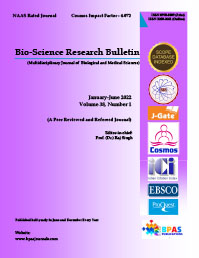Antimicrobial Activity and Phytochemical Analysis of Catharanthus roseus (L)
DOI:
https://doi.org/10.48165/Keywords:
Catharanthus roseus (L), Animicrobial, Phytochemical, Alkaloids, Asthma, Malaria etcAbstract
Catharanthus roseus (L) a popular ornamental plant found in garden, home across the worldwhich is recognized in Ayurveda. Catharanthus is well known due to antitumor, anti-diabetic, anti-microbial, anti-oxidant and anti-mutagenic effects. It produces alkaloids, vincristine vinblastine, ajmalicine, reserpine, serpentine, catharanthaine, lochherin, lochnericine, vinorelbin extract from these plants used in disease treatment. Application of Catharanthus roseus it used treatment of asthma, blood pressure, manstruation cycle, malaria etc. Plants have proved to be significant natural resources for effective chemotherapeutic agents and offering a broad spectrum of activity with greater emphasis on preventive action.The antimicrobial activity has been checked against microorganisms like Pseudomonas aeruginosa, Salmonella typhimurium, Staphylococcus aureus, E. coli, Rhizopusarrhizus, Aspergillus sydowi, and Aspergillus fumigatus.The strongest inhibition activity of the leaf extract was observed against B. subtilis, (20 mm zone) by Aspergillus sydowi, which is 21 mm zone of inhibition. Qualitative analysis of phytochemical screening reveals the presence of terpenoids, carbohydrate alkaloids, phenol, glycoside are present.
References
Ajaib M, Khan Z.U.D, Khan N. and Wahab M. (2010). Ethnobotanical studies on useful shrubs of District Kotli, Azad Jammu & Kashmir, Pakistan. Pak. J. Bot. 42:1407-1415.
Balaji H. and Versatile (2014). Therapeutic effects of Vincarosea Linn. Int. J. Pharma. Sci. Hlth. Care. 1(4) 59-76.
Cragg G.M. and Newman D.J.(2005). Plants as a source of anti-cancer agents. Ethnopharmacol. 100: 72-79.
Kabesh K. Senthilkumar P., Ragunathan R. and Kumar R. (2015). Phytochemical analysis of Catharanthus roseus plant extract and its antimicrobial activity. Int. J. Pure Appl. Biosci. 3(2): 162-172.
Khilnani K. (2018). Phytochemical analysis of Cathranthus roseus L(G) DON. Int. J Res. Appl. Sci. Bio Tech. 5(3): 1-8.
Kumari K. and Gupta S. (2013). Phytopotential of Catharanthus roseus L. (G.) Don. var. “Rosea” and “Alba” against various pathogenic microbes in vitro. Int. J. Res. Pure Appl. Microbiol. 3(3): 77-82.
Satish S., Raveesha K.A. and Janardhana G.R. (2009). Antibacterial activity of plant extracts on phytopathogenic Xanthomonas campestris pathovars. Lett. Appl. Microbiol. 28:145-147. 8. Shalini, S. and Prema, S.K. (2012). Phytochemical screening and antimicrobial activity of plant extracts for disease management. Int. J. Curr. Sci. 209-218.
